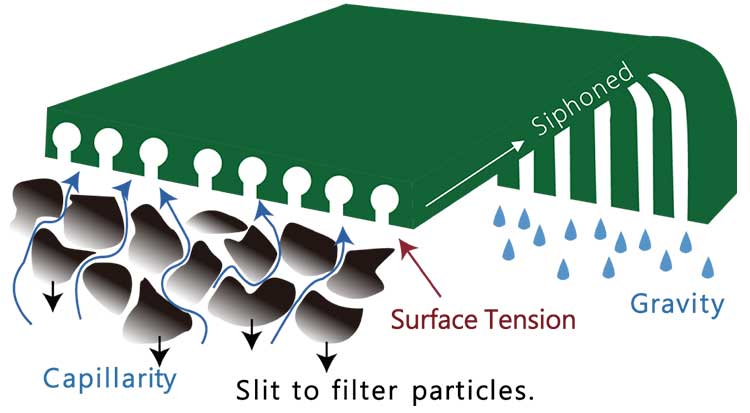The slits in the belt suck water by capillary action and fill the grooves and straw-like cavities with water. Once the straw-like cavities are filled with water, gravity causes the water to flow along the “straw” to the point of discharge, where a suction pressure is created by siphonic action, thus augmenting the natural wicking suction force that removes water from the soil.
HOW DOES IT WORK?
Short Answer:
Long Answer:
The belt harnesses the natural intermolecular forces between water and its surrounding solid surfaces. These forces are cohesion between water molecules (otherwise known as surface tension) and adhesion of the water molecules to other surfaces. When the diameter of a tube, pore or groove is small enough these two forces combine to create capillary action, the sucking of water against the force of gravity.
Soil behaves like a sponge, retaining water in its pores by capillary action. A saturated soil contains free water as well as water held by capillary action; the free water is that which is held in the larger pores/cracks which is not held by capillary action and thus can drain by gravity.
The more finely textured the soil, such as clay, the greater will be the number of small pores and thus the greater amounts of water will be retained in the soil by capillary action. A coarsely textured soil, such as sand, has a higher proportion of larger pores and contains more free water.
Conventional drainage systems, comprising perforated pipes and gravel/sand media, rely entirely on gravity alone for the removal of the free water from soil. With conventional drainage, once free water is removed the drainage rate dramatically slows down and the water that is held by capillary action stays in the soil. This state is known as the Field Capacity of the soil. At this state, soil water is removed only very slowly by evaporation from the surface and uptake by plant roots and evaporation from plant leaves (known as evapotranspiration).
However Drainbelt and Draintube removes the free water and then continues to remove water from soil by the capillary and siphonic action of the narrow grooves, continuing to drain water even after the phreatic surface (or water table) is below the Drainbelt or Draintube.

